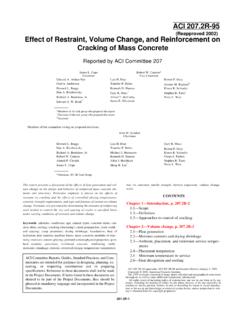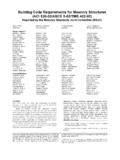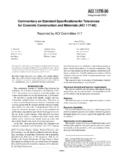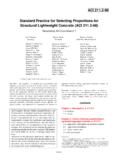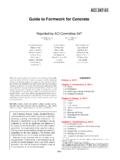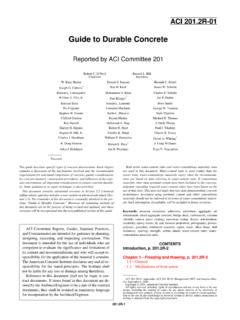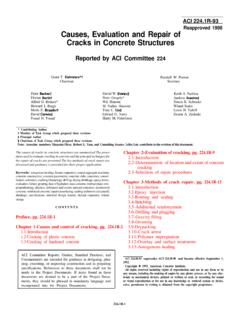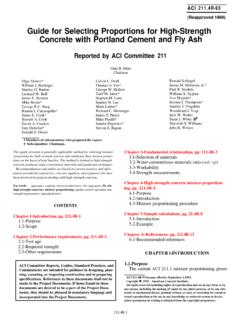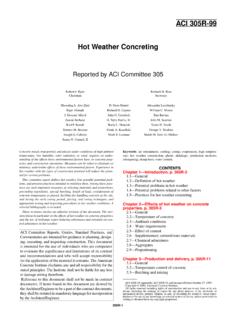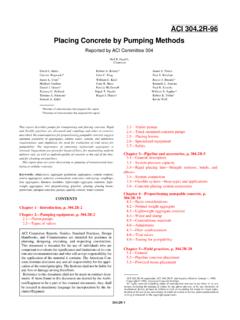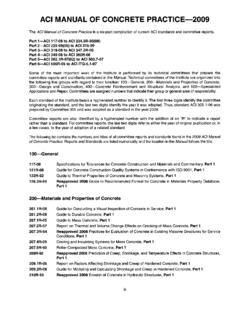Transcription of 207.4R-93 Cooling and Insulating Systems for …
1 Cooling and Insulating Systems for MassACI (Reapproved 1998)ConcreteReported by ACI Committee 207 John M. ScanlonChairmanTerry W. West*Task Group ChairmanFred A. AndersonHoward L BoggsDan A. BonikowskyRichard BradshawEdward BushRobert W. CannonJames L. CopeLuis H. DiazTimothy P. DolenJames R. GrahamMichael I. HammonsKenneth D. HansenMeng K. LeeGary R. MassJames E. OliversonRobert F. OuryErnest K. Schrader*Stephen B. Tatro*l Task group memberThe need to control volume change induced primarily by temperaturechange in mass concrete has led to the development of Cooling and in-sulating Systems for use in mass concrete construction.
2 This report reviewsthe development of these system the need for temperature control; pre- Cooling post- Cooling and Insulating Systems currently being used; andexpected trens. A simplified method for computing the temperature offreshly mixed concrete cooled by various Systems is also thermal elastic shockKeywords: admixtures; cement content; cement types; coarse aggregate; coolingpipes; creep; formwork (construction); heat of hydration; ice; insulation; massconcrete; modulus of elasticity; precooling; post- Cooling ; pozzolans; restraints;specific heat; strains; stresses; temperature rise (in concrete); tensile straincapacity; tensile strength; thermal conductivity; thermal diffusivity.
3 Thermalexpansion; thermal gradient; thermal shock; thermal 3-Precooling Systems , pg. waterCONTENTSC hapter l-Introduction, pg. and of construction gains during concreting plant areaChapter 2-Need for temperature control, pg. 4-Post- Cooling Systems , pg. and pumping flow dimensionsChapter 5-Surface insulation, pg. surfacesACI Committee Reports, Guides, Standard Practices, andCommentaries are intended for guidance in designing, plan-ning, executing, or inspecting construction and in preparingspecifications.
4 References to these documents shall not bemade in the Project Documents. If items found in thesedocuments are desired to be a part of the Project Docu-ments, they should be phrased in mandatory language andincorporated into the Project supersedes ACI (Revised 1986) and became effectiveSeptember 1, 8 1993 American Concrete rights reserved including rights of reproduction and use in any form or byany means, including the making of copies by any photo process, or by any elec-tronic or mechanical device, printed or written or oral, or recording for sound orvisual reproduction or for use in any knowledge or retrieval system or device.
5 Unless permission in writing is obtained from the copyright ACI COMMITTEE and absorption from light energy requirementsChapter 6-Expected trends, pg. of aggregate control insulation and precast concreteChapter 7-References, pg. referencesCHAPTER and objectiveThis report presents a discussion of special construc-tion procedures which can be used to control the temper-ature changes which occur in concrete structures. Theprincipal construction practices covered are precooling ofmaterials, post- Cooling of in-place concrete by embeddedpipes, and surface insulation.
6 Other design and construc-tion practices, including the selection of cementingmaterials, aggregates, chemical admixtures, cement con-tent, and strength requirements are not within the scopeof this objective of this report is to summarize experi-ences with Cooling and Insulating Systems , and to offerguidance on the selection and application of these proce-dures in design and construction for controlling thermalcracking in all types of concrete - Historical backgroundThe first major use of artificial Cooling (post- Cooling )of mass concrete was in the construction of the Bureauof Reclamation s Hoover Dam in the early 1930 s.
7 In thiscase the primary objective of the post- Cooling was to ac-celerate thermal contraction of the columns of concretecomposing the dam so that the contraction joints couldbe filled with grout to insure monolithic action of thedam. The Cooling was achieved by circulating cold waterthrough pipes embedded in the concrete. Circulation ofwater through the pipes was usually started several weeksor more after the concrete had been placed. Since Hoo-ver Dam, post- Cooling has been used in construction ofmany large dams.
8 Generally the practices followed wereessentially identical to those followed at Hoover Dam,except that circulation of Cooling water was initiatedsimultaneously with the placement of the early 1940 s the Tennessee Valley Authorityutilized post- Cooling in the construction of Fontana Damfor two purposes: (a) to control the temperature rise par-ticularly in the vulnerable base of the dam where crack-ing of the concrete could be induced by the restrainingeffect of the foundation, and (b) to accelerate thermalcontraction of the columns so that the contraction jointsbetween columns could be filled with grout to ensuremonolithic action.
9 Post- Cooling was started coincidentlywith the placing of each new lift of concrete on the pre-viously placed lift and on foundation rock. The pipespacing and lift thickness were varied to limit the max-imum temperature to a pre-designed level in all summer with naturally high (unregulated) placing tem-peratures, the pipe spacing and lift thickness for thecritical foundation zone was ft ( m); in winterwhen placing temperatures were naturally low the pipespacing and lift thickness for this zone was ft ( m).
10 Above the critical zone, the lift thickness was increasedto ft ( m) and the pipe spacing was increased ft ( m). Cooling was also started in this latterzone coincidently with the placing of concrete in eachnew the 1960 s the Corps of Engineers began the prac-tice of starting, stopping, and restarting the coolingprocess based on the results of embedded resistance ther-mometers. At Dworshak Dam and the Ice Harbor Addi-tional Power House Units, the Cooling water was stoppedwhen the temperature of the concrete near the pipesbegan to drop rapidly after reaching a peak.
